Practice Free 300-410 Exam Online Questions
Refer to the exhibit.
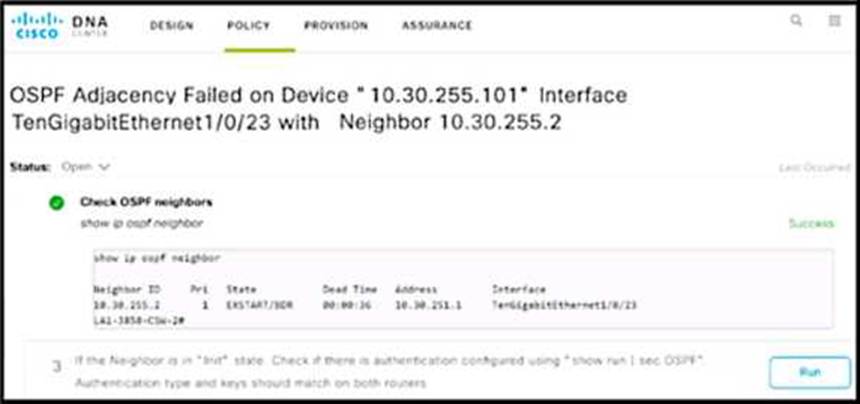
An engineer is investigating an OSPF issue reported by the Cisco DNA Assurance Center.
Which action resolves the issue?
- A . One of the neighbor links is down Bring the interface up by running shut and no shut
- B . One of the interfaces is using the wrong MTU Match interface MTU on both links
- C . An ACL entry blocking multicast on the interfaces Allow multicast through the interface ACL
- D . One of the interfaces is using the wrong authentication Match interface authentication on both links
Refer to the exhibit.
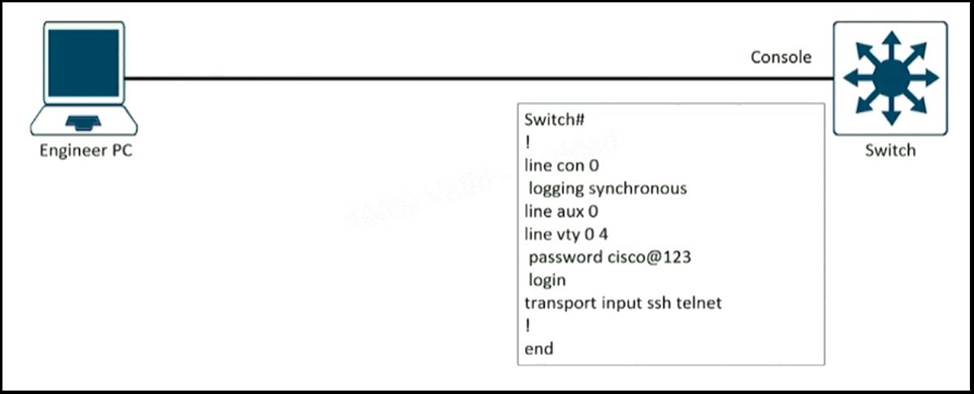
An engineer must block access to the console ports for all corporate remote Cisco devices based on the recent corporate security policy but the security team stilt can connect through the console port.
Which configuration on the console port resolves the issue?
- A . transport input telnet
- B . login and password
- C . no exec
- D . exec 0.0
C
Explanation:
“no exec” will disable access to a line. It is used if we want to allow only outgoing session (and disable incoming session) so this command will block all console port access.
There is no “exec 0 0” command. We can only find the “exec prompt” command in IOS Version 15.4(2)T4.

The most similar command is “exec-timeout 0 0” command, which is used to prevent Telnet/SSH sessions from timing out.
How does MPLS Layer 3 VPN function?
- A . When a VPN route is learned from a CE device and injected into IGP, a VPN route distinguisher attribute is associated with it.
- B . When a destination PE device receives a labeled packet, it pops the label and uses it to forward the packet to the correct CE device.
- C . When an EIGRP internal route is redistributed into BGP by one PE and then back into EIGRP by another PE, the originating router ID for the route is changed to the router ID of the first PE
- D . When a PE device forwards a packet received from a CE device across the provider network, it labels the packet with the label learned from the source PE device.
Refer to the exhibit.
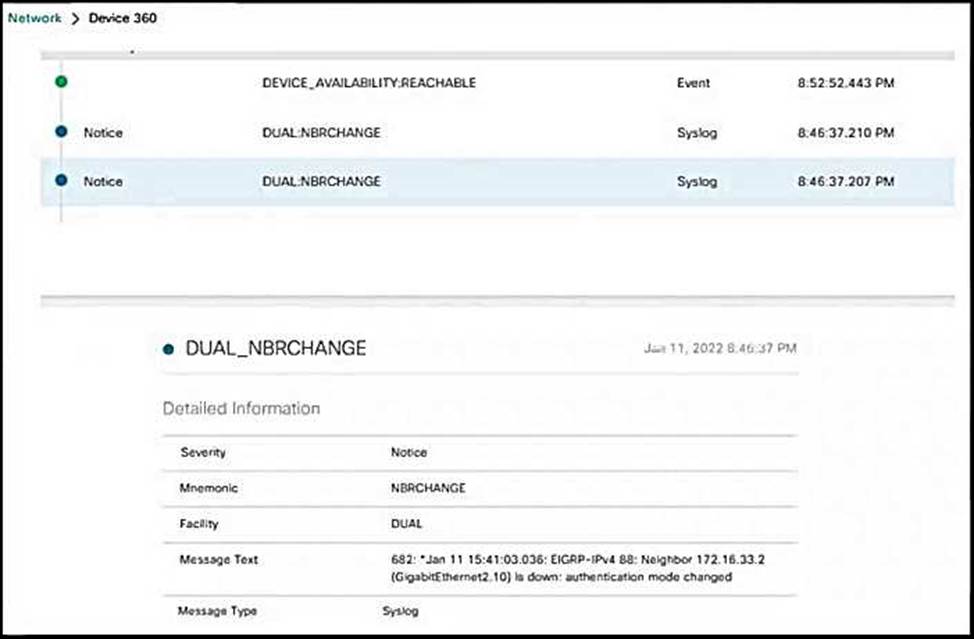
R1 test its directly connected EIGRP peer 172.16.33.2 (SW1).
Which configuration resolves the issue1?
- A . key chain EIGRP
key 1
key-string Cisco
!
interface Gigabit Ethernet 2
IP authentication mode elgrp 88 md5
IP authentication key-chain elgrp 88 EIGRP - B . key chain EIGRP
key1
key-string Cisco
!
interface Gigabit Ethernet 2.10
IP authentication mode eigrp 88 md5
IP authentication key-chain eigrp 88 Cisco - C . key chain EIGRP
key 1
key-string Cisco
!
interface Gigabit Ethernet 2.10
IP authentication mode elgrp 88 md5
IP authentication key-chain eigrp 88 EIGRP - D . key chain EIGRP
key1
key-string Cisco
!
interface Gigabit Ethernet 2
IP authentication mode eigrp 88 md5
IP authentication key-chain elgrp 88 Cisco
An engineer configured Reverse Path Forwarding on an interface and noticed that the routes are dropped when a route lookup fails on that interface for a prefix that is available in the routing table.
Which interface configuration resolves the issue?
- A . ip verify unicast source reachable-via rx
- B . ip verify unicast source reachable-via any
- C . ip verify unicast source reachable-via allow-default
- D . ip verify unicast source reachable-via 12-src
B
Explanation:
According to this question, uRPF is running in strict mode because packets are dropped even when that route exists in the routing table. Maybe packets are dropped because the receiving interface is different from the interface the local router uses to send packets to that destination. The ip verify unicast source reachable-via rx command enables Unicast RPF in strict mode.
To enable loose mode, administrators can use the any option (ip verify unicast source reachable-via any). In loose mode, it doesn’t matter if we use this interface to reach the source or not.
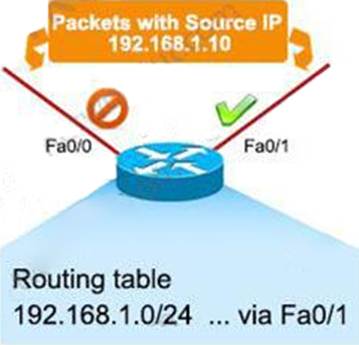
The allow-default option allows the use of the default route in the source verification process.
Refer to the exhibit.

During ISP router maintenance, the network produced many alerts because of the flapping interface.
Which configuration on R1 resolves the issue?
- A . no snmp trap link-status
- B . snmp trap link-status down
- C . snmp trap ip verify drop-rate
- D . ip verify drop-rate notify hold-down 60
An engineer notices that R1 does not hold enough log messages to Identity the root cause during troubleshooting.
Which command resolves this issue?
- A . #logging buffered 4096 critical
- B . (config)#logging buffered 16000 informational
- C . #logging buffered 16000 critical
- D . (config)#logging buffered 4096 informational
Refer to the exhibit.
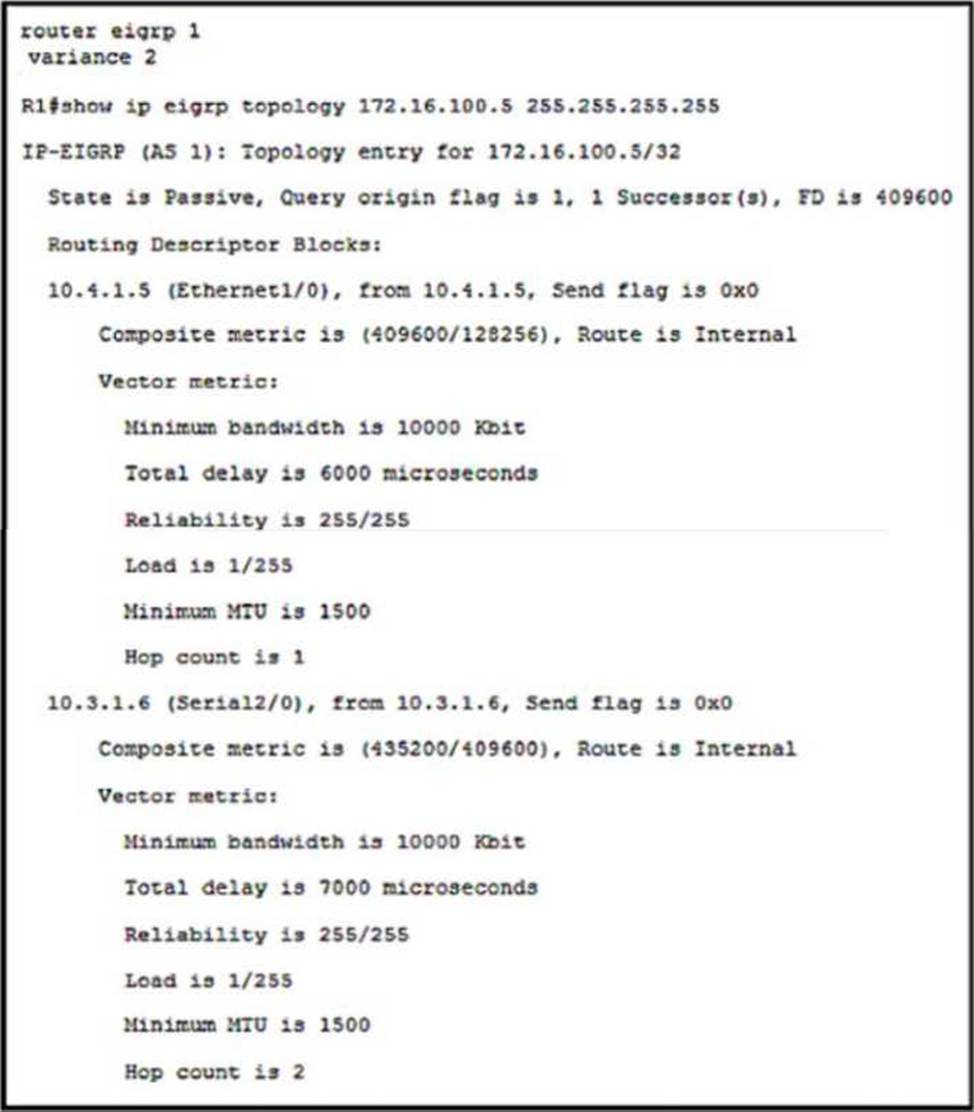
A network engineer troubleshooting a packet drop problem for the host 172.16.100.5 notices that only one link is used and installed on the routing table, which saturates the bandwidth.
Which action must the engineer take to resolve the high bandwidth utilization problem and share the traffic toward this host between the two available links?
- A . Set the eigrp variance equal to 4 to install a second route with a metric not larger than 4 times of the best metric.
- B . Change the EIGRP delay metric to meet the feasibility condition.
- C . Set the eigrp variance equal to 3 to install a second route with a metric not larger than 3 times of the best metric.
- D . Disable the eigrp split horizon loop protection mechanism.
What are the two goals of micro BFD sessions? (Choose two.)
- A . The high bandwidth member link of a link aggregation group must run BFD
- B . Run the BFD session with 3×3 ms hello timer
- C . Continuity for each member link of a link aggregation group must be verified
- D . Eny member link on a link aggregation group must run BFD
- E . Each member link of a link aggregation group must run BFD.
C,E
Explanation:
https://www.cisco.com/c/en/us/td/docs/ios-xml/ios/iproute_bfd/configuration/xe-16-8/irb-xe-16-8-book/irb-micro-bfd.html
When configuring Control Plane Policing on a router to protect it from malicious traffic, an engineer observes that the configured routing protocols start flapping on that device.
Which action in the Control Plane Policy prevents this problem in a production environment while achieving the security objective?
- A . Set the conform-action and exceed-action to transmit initially to test the ACLs and transmit rates and apply the Control Plane Policy in the output direction
- B . Set the conform-action and exceed-action to transmit initially to test the ACLs and transmit rates and apply the Control Plane Policy in the input direction
- C . Set the conform-action to transmit and exceed-action to drop to test the ACLs and transmit rates and apply the Control Plane Policy m the input direction
- D . Set the conform-action to transmit and exceed-action to drop to test the ACLs and transmit rates and apply the Control Plane Policy m the output direction
